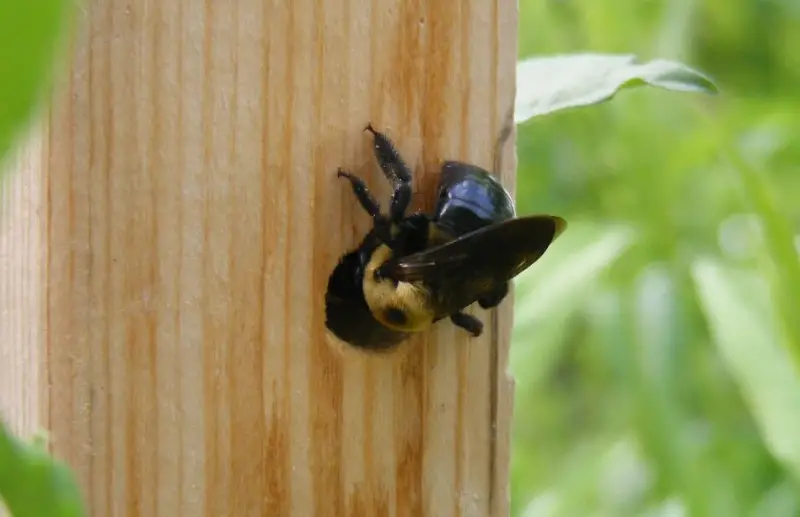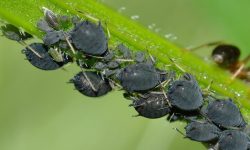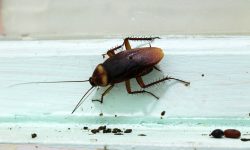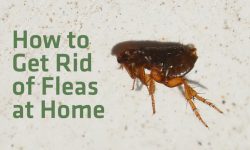Carpenter bees may seem harmless at first glance, but they can cause significant damage to wooden structures around your home. Unlike termites, they don’t eat wood but rather bore into it to create nesting sites, weakening the structural integrity over time. Fortunately, you don’t need harsh chemicals to get rid of them.
In this guide, we’ll explore how to get rid of carpenter bees naturally using effective and eco-friendly methods.
Why Are Carpenter Bees a Problem?

Carpenter bees are notorious for boring perfectly round holes into wood to create tunnels where they lay eggs. Although they don’t consume the wood, their tunneling can lead to structural damage over time. If left unchecked, carpenter bees can weaken decks, fences, wooden siding, and other wooden structures around your property.
Additionally, while male carpenter bees can’t sting, they are known for their aggressive behavior when protecting nesting sites. Female carpenter bees can sting if provoked, posing a risk to humans and pets.
Signs of Carpenter Bee Infestation
Before learning how to get rid of carpenter bees naturally, it’s essential to confirm their presence. Look for these common signs:
- Perfectly round holes in wooden surfaces, about half an inch in diameter.
- Sawdust or wood shavings beneath the holes.
- Yellowish stains caused by excrement near entry points.
- Buzzing sounds coming from within wooden structures.
Once you’ve confirmed carpenter bees are the culprits, you can proceed with natural methods to remove them.
7 Effective Methods to Get Rid of Carpenter Bees Naturally
1. Citrus Spray
Citrus is a powerful natural repellent for carpenter bees due to its strong, zesty scent, which they find highly unpleasant. Unlike chemical insecticides, citrus sprays are non-toxic, safe for humans and pets, and eco-friendly. Here’s how to make and use citrus spray effectively:
How to Make Citrus Spray
- Choose your citrus fruits: Lemon, orange, lime, or grapefruit all work well. The stronger the scent, the more effective the spray.
- Boil citrus peels: Collect the peels from 3-4 citrus fruits and place them in a pot of water. Bring to a boil and let it simmer for about 15 minutes. This process extracts the natural oils from the peels.
- Cool and strain: Allow the mixture to cool, then strain out the peels.
- Pour into a spray bottle: Transfer the citrus-infused water into a spray bottle for easy application.
How to Use Citrus Spray
- Target carpenter bee holes: Spray the citrus solution directly into existing holes and tunnels made by carpenter bees. This repels the bees and discourages them from returning.
- Apply around wooden surfaces: Spray generously around wooden structures, including decks, fences, and eaves, to prevent new infestations.
- Reapply regularly: Reapply every few days, especially after rain, to maintain the repellent effect.
Why It Works
Carpenter bees have a keen sense of smell and are particularly sensitive to citrus scents. The strong aroma disrupts their nesting instincts and forces them to seek alternative sites.
2. Essential Oils
Essential oils are another potent natural repellent against carpenter bees. These oils are derived from plants and contain powerful aromatic compounds that carpenter bees dislike.
Most Effective Essential Oils
- Tea tree oil – Known for its strong, medicinal scent.
- Eucalyptus oil – Has a sharp, camphor-like aroma.
- Peppermint oil – Refreshing and intense, effectively masking the pheromones carpenter bees use to communicate.
- Citrus oil – Similar to homemade citrus spray but more concentrated.
How to Make and Use Essential Oil Spray
- Mix the solution: Combine 10-15 drops of essential oil with water in a spray bottle. Add a few drops of dish soap to help the mixture adhere to surfaces.
- Spray the nesting areas: Apply directly into carpenter bee holes, around the entry points, and on wooden surfaces where they are active.
- Reapply as needed: Essential oils evaporate quickly, so reapply every few days for maximum effectiveness.
Additional Tips
- For a more potent solution, mix multiple oils (e.g., peppermint and tea tree oil).
- You can also soak cotton balls in the essential oil mixture and place them near nesting sites to maintain a constant repellent scent.
Why It Works
Essential oils overwhelm the bees’ olfactory senses, making the nesting area undesirable. They also act as a natural barrier, preventing new carpenter bees from establishing nests.
3. Noise and Vibration
Carpenter bees are sensitive to noise and vibrations. Loud sounds and constant vibrations disturb their nesting environment, making it inhospitable. This method is particularly useful for active nests where other repellents may not reach.
How to Use Noise and Vibration
- Set up a portable speaker: Place a speaker near the carpenter bee holes. The closer, the better, as vibrations travel through the wooden structure.
- Play loud music or vibrations: Choose bass-heavy music or specific vibration soundtracks available online.
- Duration and frequency: Play the sounds for several hours daily until the carpenter bees leave the area.
Additional Tips
- Evening or nighttime application is most effective since bees are typically inside the nest during these times.
- Once the bees leave, immediately seal the holes to prevent them from returning.
Why It Works
Carpenter bees are highly sensitive to vibrations, which interfere with their communication and nesting behavior. Prolonged exposure to noise makes the nesting site uninhabitable, forcing them to relocate.
4. Wooden Hole Plugs and Putty
Once the carpenter bees have vacated the nest, it is crucial to seal the holes to prevent re-infestation. Carpenter bees often return to old nesting sites, so proper sealing is necessary.
Materials Needed
- Wooden dowels or plugs that fit the size of the holes.
- Wood putty to cover the holes and smooth the surface.
- Sandpaper to even out the patched area.
- Paint or varnish for additional protection.
Steps to Seal Carpenter Bee Holes
- Ensure all bees are gone: Do this in the evening when bees are less active, or use noise methods to ensure they’ve left.
- Optional – Apply insecticidal dust: This helps eliminate any remaining larvae inside the tunnels.
- Insert wooden dowels or fill with wood putty: Make sure the plugs fit snugly. Smooth out the surface with wood putty.
- Sand and paint: Sand the area once the putty dries, then paint or varnish the wood. This not only conceals the repairs but also deters future nesting.
Why It Works
Sealing the holes eliminates the entry points, preventing carpenter bees from returning. Painting or varnishing the wood further deters them, as they prefer untreated, weathered wood.
5. Natural Bee Repellents
Certain natural substances effectively repel carpenter bees:
- Cinnamon powder – Its strong aroma confuses the bees and masks the pheromones they use to navigate. Sprinkle around entry points and nesting sites.
- Almond oil – Its potent smell acts as a natural deterrent. Apply using a cloth or spray bottle around nesting areas.
- Vinegar spray – Mix equal parts vinegar and water. Spray around carpenter bee holes to repel them.
Why It Works
These substances contain naturally occurring compounds that carpenter bees find unpleasant. Their strong scents interfere with the bees’ sense of direction and nesting instincts.
6. Carpenter Bee Traps
Carpenter bee traps are designed to mimic nesting sites, luring the bees inside where they become trapped and cannot escape.
How to Make a Carpenter Bee Trap
- Wooden box with a slanted roof – Mimics a nesting site.
- Drilled holes – Make holes at an upward angle, similar to the ones carpenter bees create.
- Clear plastic bottle – Attach at the bottom to capture and contain the bees.
How It Works
The bees enter the holes thinking they’ve found a nesting site but get trapped in the bottle, unable to find the exit.
7. Preventive Measures
Preventing carpenter bees from returning is just as important as getting rid of them. Consider these preventive measures:
- Paint or varnish wooden surfaces – Carpenter bees prefer untreated wood. A protective coat makes it less appealing.
- Install hardwood or metal siding – Consider replacing softwood areas with hardwood or metal alternatives.
- Cover exposed wood – Use vinyl or aluminum wraps to cover beams and rafters.
- Regular inspection and maintenance – Early detection of holes or sawdust can prevent large-scale infestations.
Why It Works
Carpenter bees are attracted to exposed, weathered wood. By maintaining and protecting wooden surfaces, you reduce the risk of infestations.
Why Choose Natural Methods?
Using natural methods to get rid of carpenter bees is not only environmentally friendly but also safer for your family and pets. Chemical pesticides can be harmful, whereas natural repellents like essential oils and citrus sprays are non-toxic and effective.
Additionally, carpenter bees play a role in pollination. Using natural methods allows you to repel them without harming them, contributing to a healthier ecosystem.
When to Call a Professional
If the infestation is severe or the carpenter bees have caused significant structural damage, it may be time to call a professional pest control service. Professionals can assess the damage, safely remove the bees, and provide long-term prevention solutions.
Conclusion
Carpenter bees can be a nuisance, but you don’t need harsh chemicals to get rid of them. By using natural methods like citrus spray, essential oils, noise and vibration, and preventive measures, you can effectively repel carpenter bees and protect your wooden structures.
With a proactive approach and consistent maintenance, you can enjoy a bee-free home while staying environmentally conscious. Try these 7 effective methods today and reclaim your space from carpenter bees—naturally and safely!






